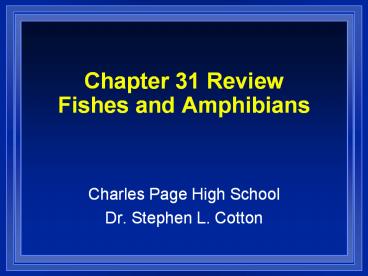Chapter 31 Review Fishes and Amphibians - PowerPoint PPT Presentation
1 / 15
Title:
Chapter 31 Review Fishes and Amphibians
Description:
... male seahorse The heyday of the amphibians ended because climate change How do adult amphibians typically get their food? carnivores What part of the frog and ... – PowerPoint PPT presentation
Number of Views:108
Avg rating:3.0/5.0
Title: Chapter 31 Review Fishes and Amphibians
1
Chapter 31 ReviewFishes and Amphibians
- Charles Page High School
- Dr. Stephen L. Cotton
2
Chapter 31 ReviewFishes and Amphibians
- A vertebrate that has moist skin with glands, but
lacks scales and claws is a(n) amphibian - If an amphibian still has a tail after it
undergoes the process of metamorphosis, it is
probably a salamander
3
Chapter 31 ReviewFishes and Amphibians
- As adults, both frogs and toads have hind legs
adapted for jumping - To breathe, adult amphibians (unlike the larvae)
use their lungs - In the circulatory system of adult amphibians,
the first loop carries what oxygen-content of
blood, and to what location? Oxygen-poor to the
lungs
4
Chapter 31 ReviewFishes and Amphibians
- Fishes are characterized by each of the following
except a bony skeleton scales fins pharyngeal
gills - Describe the first fishes according to their body
covering and jaws. Covered with bony plates and
jawless
5
Chapter 31 ReviewFishes and Amphibians
- The pectoral fins of fishes evolved into what
structure in terrestrial animals? forelimbs - What is the largest known fish? White shark
- Discuss some of the extraordinary feeding
adaptations of fish. Lighted lures, shoots down
insects with water, long snout with teeth, teeth
fused to short beak
6
Chapter 31 ReviewFishes and Amphibians
- In fishes, blood from the muscles and organs
collects in the sinus venosus - Give some examples of the jawless fishes.
Lampreys and hagfish - How do skates and rays move? Wing-like pectoral
fins - Why are coelacanths important in evolutionary
history? Nearest land ancestor
7
Chapter 31 ReviewFishes and Amphibians
- Adult amphibians are vertebrates, but do they lay
eggs with a shell on them? no - Huge amphibians became so numerous 345 to 285
million years ago that the term Age of
Amphibians is often applied to this period named
carboniferous Period.
8
Chapter 31 ReviewFishes and Amphibians
- How do tadpoles, salamander larvae, and a few
adult salamanders get rid of excess carbon
dioxide? through their skin - The heart of a tadpole has how many chambers? two
- In vertebrates, what are the tubes that carry
urine from the kidneys? ureters
9
Chapter 31 ReviewFishes and Amphibians
- In an amphibian, what does the nictitating
membrane cover? eye - In a frog, blood returning from the legs collects
in the vena cava - The red eft is a stage of development of the
crimson-spotted newt - The circulatory system of a fish is called a
singe-loop.
10
Chapter 31 ReviewFishes and Amphibians
- If a fish is cartilaginous and has jaws, it is
classified in the class chondrichthyes - The kidneys of a freshwater fish pump out much
dilute urine. - Salmon can distinguish between the odor of their
home stream and others by using their
chemorecepters
11
Chapter 31 ReviewFishes and Amphibians
- Give an example of an oviparous fish that cares
for their young. Siamese fighting fist,
sticklebacks, cichlids and catfish, male seahorse
- The heyday of the amphibians ended because
climate change - How do adult amphibians typically get their food?
carnivores - What part of the frog and toad brain coordinates
jumping? cerebellum
12
Chapter 31 ReviewFishes and Amphibians
- Were the first fishes armored with jaws? No,
jawless - How many species of living lobe-finned fishes are
there today? two - The feeding adaptation in fish that
revolutionized vertebrate evolution was the jaw
13
Chapter 31 ReviewFishes and Amphibians
- During the Ordovician and Silurian Periods,
jawless fishes underwent a major adaptive
radiation.
14
Chapter 31 ReviewFishes and Amphibians
- In moist woods, look under logs and rocks to find
toads. - Fishes in which embryos are nourished directly
inside the body are called viviparous - Because of their external fertilization, frogs
must be oviparous
15
Chapter 31 ReviewFishes and Amphibians
- A fish in which the teeth are constantly replaced
throughout life is the shark - The armored jawless fishes were ultimately an
evolutionary dead end.

